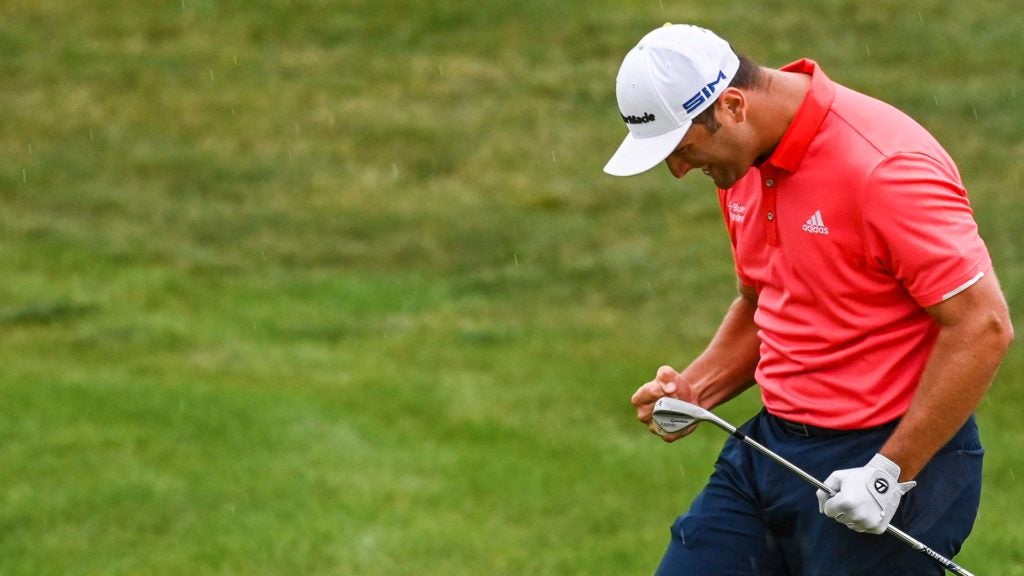When you’re winning by five, a two-stroke penalty doesn’t mean much. But the awarding of said penalty could set a precedent with major consequences. On Wednesday, three members of ESPN’s golf broadcast team mused on the implications of the penalty Jon Rahm accepted at the conclusion of the Memorial Tournament — and how it could have been handled differently.
First, a quick refresher: Rahm held a four-shot lead over playing partner Ryan Palmer when he faced down a short-sided chip on the par-3 16th hole at Muirfield Village. That’s when he pulled off the iconic shot of the PGA Tour’s latest mini-season, landing the ball in the perfect spot and watching as it trickled into the center of the cup for an improbable birdie 2.
But upon review, Rahm’s wedge had actually moved the position of the ball ever so slightly before he hit the shot. After consulting with rules official Slugger White post-round, that birdie 2 became a bogey 4. Rahm’s five-shot win became a three-shot win. Curtis Strange, for one, didn’t think much of the penalty.
Speaking on ESPN’s pre-PGA Championship conference call (ESPN is airing “the most hours ever” during next week’s major championship), Strange summed up his feelings on the matter.
“Jon Rahm said he didn’t see it move. That should have been the end of the conversation,” Strange said. “Because the rule states that if the player didn’t see it and then the high definition camera says it moved just a fraction, then no penalty.”
Strange didn’t care for the taste the post-round penalty left in his mouth, nor the way it took attention away from Rahm’s victory.
“I didn’t like it at all. That’s all I have to say,” he said.
But it wasn’t actually all he had to say; the remarks spurred an interesting discussion between Strange, Scott van Pelt and Andy North. First, van Pelt suggests that this exact sort of situation was supposed to get eliminated with a series of rules changes allowing some latitude for imperceptible ball movement.
“Just philosophically we’ve had these conversations, guys as a group sitting in the TV compound, for years,” he said. “You put a camera on Rahm with high definition and see it move ever so slightly. Granted, he had the big lead so it was a lot easier to slap that penalty on him. If he was up one, what do you do? I don’t know.”
He also pointed out the disproportionate scrutiny placed on golfers playing on camera.
“So he’s the leader and you had however many high definition cameras trained on every move he makes. Well, Thursday or Friday you’ve got people going off two tees, so somebody is on the 3rd hole, nobody is paying any attention and the ball moves just as much or more but nobody saw it happen so nobody is there to police it. So you’re effectively ruling incorrectly.
“Like, you’re not applying the same standards to all the competitors, and that’s where I know we’ve had these conversations throughout the years where you’re like, well, how is that reasonable, which is why I believe they stopped taking that sort of viewer feedback from the person sitting on his or her couch going, ‘hey, that’s a rules infraction,’ which I was all for.”
North agreed with Strange’s line of thinking, suggesting that if neither Rahm nor the player keeping his card say anything and were willing to sign for that number, that should be the end of the story.
A reporter asked how that philosophy would apply in the case of Patrick Reed at the Hero World Challenge, where Reed was penalized after moving sand from his lie in a fairway bunker.
“That’s definitely a different situation, because in the Reed thing it was more obvious, and he did it twice. In Rahm’s case, again, I think it was contradictory to the new rule — and if I’m wrong, somebody speak up — but if he didn’t see it and the high definition saw it, we all saw how little it actually did move, and in high grass, God knows how many times that’s happened over the years and you don’t see it.
“That was supposed to be the end of the conversation, but they decided to put two on him, and I just — I didn’t agree.”
The new rule Strange is referring to is Decision 34-3/10: Limitations on Use of Video Evidence, which reads as follows:
“If the Committee concludes that such facts could not reasonably have been seen with the naked eye and the player was not otherwise aware of a potential breach of the Rules, the player will be deemed not to have breached the Rules, even when video technology shows otherwise.”
Ultimately, White decided to stick with the basics laid out in Rule 9.4. “It was a ball at rest by the player, moved, and since he didn’t put it back, he was assessed a general penalty, which is two strokes. That’s pretty much the bottom line,” he said, explaining that Rahm had agreed to take the penalty without argument.
On the ESPN call, North had the final word on the matter, invoking a lesson he learned from the Memorial Tournament’s host.
“Jack Nicklaus for his entire career has never grounded his golf club, and he told me that that is the reason, that if it doesn’t get grounded, there’s nothing they can ever say to you about it. I think that’s pretty darned smart,” he said.
Fair point.
